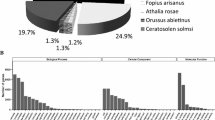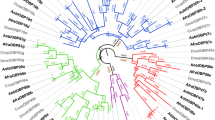Abstract
Insect odorant-binding proteins (OBPs) function in the perception of chemical cues such as pheromones and host-plant odors. Comparative genomic analysis has shown that OBP genes underwent the birth-and-death process through the evolution of Hexapoda, resulting in diverged OBP repertoires between distantly related species. On the other hand, comparisons between closely related species, particularly those species with different degrees of host specialization, are limited. In this study, 20 novel OBP genes were identified from Delia platura (Meigen) by transcriptome analysis in the antennae and legs. The repertoire of OBP genes was compared with that of a closely related species, Delia antiqua (Meigen). Although D. platura is a generalist while D. antiqua is a specialist in regard to their host utilization, expression profiles of these OBPs were almost identical between the two species. Evolutionary analysis showed that at least 14 OBPs have been under purifying selection, suggesting that they have a similar function in both species. These results suggest that the repertoire of OBPs was relatively independent from host specialization in these species.




Similar content being viewed by others
References
Almeida FC, Sanches-Gracia A, Campos JL, Rozas J (2014) Family size evolution in Drosophila chemosensory gene families: a comparative analysis with a critical appraisal of methods. Genome Biol Evol 6:1669–1682
Ellis SA, Scatcherd JE (2007) Bean seed fly (Delia platura, Delia florilega) and onion fly (Delia antiqua) incidence in England and an evaluation of chemical and biological control options. Ann Appl Biol 151:259–267
Gomez-Diaz C, Reina JH, Cambillau C, Benton R (2013) Ligands for pheromone-sensing neurons are not conformationally activated odorant binding proteins. PLoS Biol 11:e1001546
Gouinguene SP, Stadler E (2006) Oviposition in Delia platura (Diptera, Anthomyiidae): the role of volatile and contact cues of bean. J Chem Ecol 32:1399–1413
Gouinguene S, Buser HR, Stadler E (2005) Host-plant leaf surface compounds influencing ovipositon in Delia antiqua. Chemoecology 15:243–249
Grabherr MG et al (2011) Full-length transcriptome assembly from RNA-seq data without a reference genome. Nat Biotechnol 15:644–652
Hallem BA, Carlson JR (2006) Coding of odors by a receptor repertoire. Cell 125:143–160
Harada E, Haba D, Aigaki T, Matsuo T (2008) Behavioral analyses of mutants for two odorant-binding protein genes, Obp57d and Obp57e, in Drosophila melanogaster. Genes Genetic Syst 83:257–264
Harada E, Nakagawa J, Asano T, Taoka M, Sorimachi H, Ito Y, Aigaki T, Matsuo T (2012) Functional evolution of duplicated odorant-binding protein genes, Obp57d and Obp57e, in Drosophila. PLoS One 7:e29710
Ishikawa Y, Mochizuki A, Ikeshoji T, Matsumoto Y (1983) Mass-rearing of the onion and seed-corn flies, Hylemya antiqua and Hylemya platura (Diptera, Anthomyiidae), on an artificial diet with antibiotics. Appl Entomol Zool 18:62–69
Jones DT, Taylor WR, Thornton JM (1992) The rapid generation of mutation data matrices from protein sequences. Comput Appl Biosci 8:275–282
Koutroumpa FA, Kárpáti Z, Monsempes C, Hill SR, Hansson BS, Jacquin-Joly E, Krieger J, Dekker T (2014) Shifts in sensory neuron identity parallel differences in pheromone preference in the European corn borer. Front Ecol Evol 2:65
Langmead B, Salzberg S (2012) Fast gapped-read alignment with Bowtie 2. Nat Methods 9:357–359
Leal WS (2013) Odorant reception in insects: roles of receptors, binding proteins, and degrading enzymes. Annu Rev Entomol 58:373–391
Matsuo T (2008) Genes for host-plant selection in Drosophila. J Neurogenet 22:195–210
Matsuo T (2012) Contribution of olfactory and gustatory sensations of octanoic acid in the oviposition behavior of Drosophila melanogaster (Diptera: drosophilidae). Appl Entomol Zool 47:137–142
Mitaka H, Matsuo T, Miura N, Ishikawa Y (2011) Identification of odorant-binding protein genes from antennal expressed sequence tags of the onion fly, Delia antiqua. Mol Biol Rep 38:1787–1792
Ohta S, Seto Y, Tamura K, Ishikawa Y, Matsuo T (2014) Identification of odorant-binding protein genes expressed in the antennae and the legs of the onion fly, Delia antiqua (Diptera: anthomyiidae). Appl Entomol Zool 49:89–95
Pelosi P, Zhou J-J, Ban LP, Calvello M (2006) Soluble proteins in insect chemical communication. Cell Mol Life Sci 63:1658–1676
Petersen TN, Brunak S, Heijne GH, Nielsen H (2011) SignalP 4.0: discriminating signal peptides from transmembrane regions. Nat Methods 8:785–786
Roberts A, Pachter L (2012) Streaming fragment assignment for real-time analysis of sequencing experiments. Nat Methods 10:71–73
Shanbhag SR, Hekmat-Scafe D, Kim M-S, Park S-K, Carlson JR, Pikielny C, Smith DP, Steinbrecht RA (2001) Expression mosaic of odorant-binding proteins in Drosophila olfactory organs. Microsc Res Tech 55:297–306
Tamura K, Stecher G, Peterson D, Filipski A, Kumar S (2013) MEGA6: molecular evolutionary genetics analysis version 6.0. Mol Biol Evol 30:2725–2729
Vieira FG, Rozas J (2011) Comparative genomics of the odorant-binding and chemosensory protein gene families across the Arthropoda: origin and evolutionary history of the chemosensory system. Genome Biol Evol 3:476–490
Yoshizawa Y, Sato R, Tsuchihara K, Ozaki K, Mita K, Asaoka K, Taniai K (2011) Ligand carrier protein genes expressed in larval chemosensory organs of Bombyx mori. Insect Biochem Mol Biol 41:545–562
Zhang J, Rosenberg HF, Nei M (1998) Positive Darwinian selection after gene duplication in primate ribonuclease genes. Proc Natl Acad Sci USA 95:3708–3713
Author information
Authors and Affiliations
Corresponding author
Rights and permissions
About this article
Cite this article
Ohta, S., Seto, Y., Tamura, K. et al. Comprehensive identification of odorant-binding protein genes in the seed fly, Delia platura (Diptera: Anthomyiidae). Appl Entomol Zool 50, 457–463 (2015). https://doi.org/10.1007/s13355-015-0353-8
Received:
Accepted:
Published:
Issue Date:
DOI: https://doi.org/10.1007/s13355-015-0353-8




